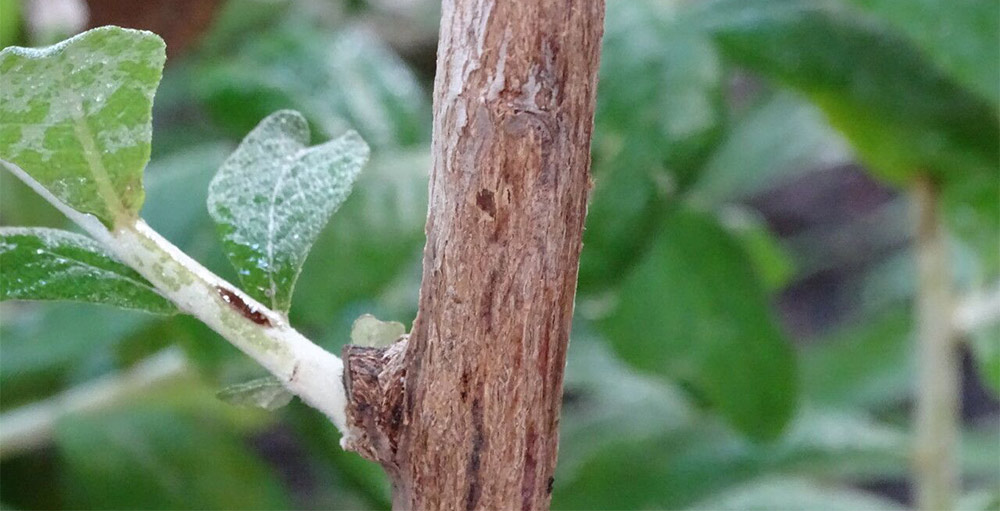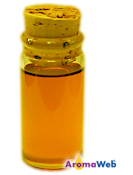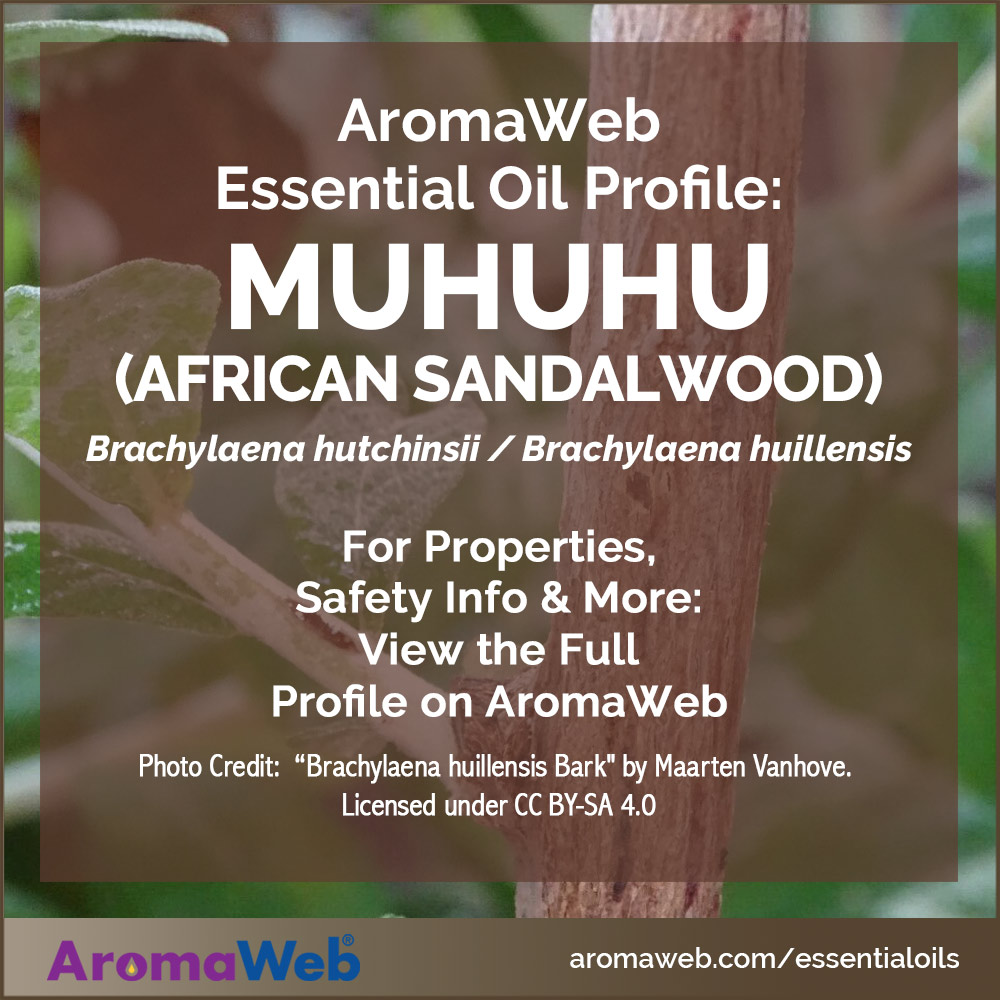Muhuhu Essential Oil (African Sandalwood Essential Oil)
Brachylaena hutchinsii / Brachylaena huillensis

Brachylaena huillensis Bark by Maarten Vanhove. Licensed under CC BY-SA 4.0
Description
Muhuhu Essential Oil is also known as African Sandalwood Essential Oil. The tree itself is sometimes known as a Silver Oak Tree or the Muhugwe Tree.
The aroma of Muhuhu Essential Oil is woody and slightly sweet/balsamic with subtle characteristics that are reminiscent to a combination of Amyris, Virginian Cedarwood and Buddha Wood. Although it is sometimes referred to as African Sandalwood (more on that below), Muhuhu Oil is not aromatically similar to East Indian Sandalwood or Australian Sandalwood Essential Oils.
Tony Burfield describes Muhuhu Essential Oil as having notes "reminiscent to guaiacol" and that the dry-down is "sweet, medicinal, methyl salicylate-like..." However, I don't find that to be representative of the Muhuhu Essential Oils that I have been recently working with. [Source: Tony Burfield, Natural Aromatic Materials: Odours & Origins, Second Edition (Tampa, FL: The Atlantic Institute of Aromatherapy, 2016), 242.]
The essential oil is frequently referred to as Muhuhu because the tree is commonly referred to as the Muhuhu Tree. Alternative names for the tree include Silver Oak and Muhugwe. Muhuhu Essential Oil is sometimes known as African Sandalwood Essential Oil, but I don't see any indication that the Muhuhu Tree itself is actually referred to as an African Sandalwood Tree. I am finding an entirely different species, Osyris lanceolata, that is referred to as the African Sandalwood Tree. [Sources: Osyris lanceolata on Wikipedia and African Sandalwood Article in Southern African Forestry Journal.
Over the past few years, I am seeing Muhuhu Essential Oil emerge as available from reputable essential oil sellers. The country of origin that I'm typically seeing for Muhuhu is Kenya.
Not much has been researched or written about Muhuhu Essential Oil from an aromatherapeutic perspective. When reviewing the identified components present in Muhuhu Essential Oil, it is primarily comprised of sesquiterpenes/sesquiterpenoids. However, it's unclear what the total composition and percentage of sesquiterpenoids is. Many components present in Mahuhu Essential Oil are still unidentified. (That is not alarming because numerous other essential oils including East Indian Sandalwood and Vetiver Essential Oils also have many components that have not yet been identified.)
Its composition of sesquiterpenes lends Muhuhu Essential Oil to be emotionally calming and to have possible use in reducing inflammation.
Muhuhu Essential Oil shows strong potential for working as an effective fragrance fixative.
I generally recommend sticking with essential oils that have more documented and reputable anecdotal evidence available. However, I find the essential oil quite intriguing and it shows interesting potential for aromatherapy applications. I added an essential oil profile for Muhuhu Essential Oil with as much info as I know since I'm seeing it becoming more readily available.

Potential Muhuhu Essential Oil Benefits and Uses
- Anti-Inflammatory
- Meditation
- Spiritual Applications
- Perfumery Fixative
Botanical Name
Brachylaena hutchinsii / Brachylaena huillensis
Plant Family
Common Method of Extraction
Steam Distilled
Plant Part Typically Used
Color
Orange / Amber
Consistency
Medium to Thick Viscosity
Perfumery Note
Base
Strength of Initial Aroma
Light to Medium
Aromatic Description
Muhuhu Essential Oil smells woody and slightly sweet/balsamic with subtle characteristics that are reminiscent to a combination of Amyris, Virginian Cedarwood and Buddha Wood.
Sustainability and Conservation Status
Near Threatened
Source: https://www.iucnredlist.org/species/33474/9786563
To learn more about the conservation status of essential oil bearing plants and how to use the IUCN Red List of Threatened Species, please refer to AromaWeb's Guide to Essential Oils and Sustainability.
Major Constituents
- a-Amorphene
- Brachyl oxide
- Copaenol
- Copaenal
- Gamma-Cadinene
- A-Calacorene
- Ylangenal
- Cubebol
See Essential Oil Safety for a more complete list of typical constituents.
Source: B.M. Lawrence, Essential Oils 1979-1980 (Wheaton: Allured Publishing, 1981), 30. Source cited in Robert Tisserand and Rodney Young, Essential Oil Safety (Second Edition. United Kingdom: Churchill Livingstone Elsevier, 2014), 355.
Muhuhu Essential Oil Safety Information
Tisserand and Young do not indicate any special precautions when using Muhuhu Essential Oil. Reading Tisserand and Young's complete profile is recommended. Source: Robert Tisserand and Rodney Young, Essential Oil Safety (Second Edition. United Kingdom: Churchill Livingstone Elsevier, 2014), 355.
Muhuhu Essential Oil References
- Tony Burfield, Natural Aromatic Materials: Odours & Origins, Second Edition (Tampa, FL: The Atlantic Institute of Aromatherapy, 2016), 242.
- Steffen Arctander, Perfume and Flavor Materials of Natural Origin (Reprint Edition. Elizabeth, NJ: Pathfinder., 2017), 421.
- Robert Tisserand and Rodney Young, Essential Oil Safety (Second Edition. United Kingdom: Churchill Livingstone Elsevier, 2014), 355.
General Safety Information
Do not take any oils internally and do not apply undiluted essential oils, absolutes, CO2s or other concentrated essences onto the skin without advanced essential oil knowledge or consultation from a qualified aromatherapy practitioner. For general dilution information, read AromaWeb's Guide to Diluting Essential Oils. If you are pregnant, epileptic, have liver damage, have cancer, or have any other medical problem, use oils only under the proper guidance of a qualified aromatherapy practitioner. Use extreme caution when using oils with children and be sure to first read the recommended dilution ratios for children. Consult a qualified aromatherapy practitioner before using oils with children, the elderly, if you have medical issues or are taking medications. Before using this or any essential oil, carefully read AromaWeb's Essential Oil Safety Information page. For in-depth information on oil safety issues, read Essential Oil Safety by Robert Tisserand and Rodney Young.
Shelf Life
Important Information About the Profiles
The essential oil information provided on AromaWeb is intended for basic educational purposes only. The references to safety information, test results, constituents and percentages is generalized information. Essential oils can vary greatly in composition. The data is not necessary complete and is not guaranteed to be accurate. The essential oil photos are intended to represent the typical and approximate color of each essential oil. However, essential oil composition and color can vary based on harvesting, distillation, age of the essential oil and other factors. Profiles for several CO2 Extracts and absolutes are included within the directory, and are denoted as such.
